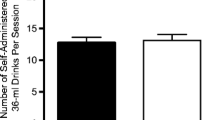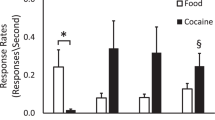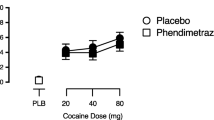Abstract
Cocaine (2 mg/kg) was given orally to 13 healthy volunteers and physiologic, subjective, attentional and performance effects were measured over a period of 4 h. Posner's reaction time paradigm measured the effects of cocaine on performance and on attention to visual cues. Cocaine increased heart rate, systolic blood pressure and pupil diameter and reduced skin temperature. Physiologic effects, subjective rating of intoxication, and cocaine levels in saliva peaked at approximately 75 min and returned to precocaine levels within 3 h. In contrast, a reaction time measure of performance speed on the visual attention task showed improvement for 4 h after cocaine. A measure of covert attention in the cocaine condition failed to show the improvement which occurred in the placebo condition. Less fatigue was reported 4 h after cocaine than after placebo. Cocaine users may experience the drug's stimulant effects considerably longer than the euphoriant effects.
Similar content being viewed by others
References
Cheney RH (1936) Reaction time behavior after caffeine and coffee consumption. J Exp Psychol 19:357–369
Clark CR, Geffen GM, Geffen LB (1989) Catecholamines and th covert orientation of attention in humans. Neuropsychologia 27:131–139
Cone EJ, Kumor K, Thompson LK, Sherer M (1988) Correlation of saliva cocaine levels with plasma levels and with pharmacologic effects after intravenous cocaine administration in human subjects. J Anal Toxicol 12:200–206
Fischman MW, Schuster CR (1980) Cocaine effects in sleep-deprived humans. Psychopharmacology 72:1–8
Gawin FJ, Ellinwood EH (1988) Cocaine and other stimulants. Actions, abuse, and treatment, N Engl J Med 318:1173–1182
Geffen G, Bradshaw TL, Wallace G (1971) Interhemispheric effects on reaction time to verbal and nonverbal visual stimuli. J Exp Psychol 87:415–422
Hauty GT, Payne RB (1955) Mitigation of work decrement. J Exp Psychol 49: 60–67
Higgins ST, Bickel WK, Hughes JR, Lynn M, Capeless M, Fenwick JW (1990) Effects of intranasal cocaine on human learning, performance and physiology. Psychopharmacology 102:451–458
Jacob P III, Elias-Baker BA, Jones RT, Benowitz NL (1987) Determination of benzoylecgonine and cocaine in biologic fluids by automated gas chromatography. J Chromatogr 417:277–286
Katz MM, Waskow IE, Olsson J (1968) Characterizing the psychological state produced by LSD. J Abnorm Psychol 73:1–14
Kinsbourne M (1973) In: Kornblum S. (ed) The control of attention by interaction between the cerebral hemispheres in attention and performance. Academic Press, New York
Kornetsky C, Mirsky AF, Kesler EK, Dorsff JE (1959) The effects of dextroamphetamine on behavioral deficits produced by sleep loss in humans. J Pharmacol 127:46–50
McNair DM, Lorr M, Doppleman LF (1971) Profile of mood states. Educational and Industrial Testing Service, San Diego
Payne RB, Moore EW (1955) The effects of some analeptic and depressant drugs upon tracking behavior. J Pharmacol 115:480–484
Posner MI (1987) Cognitive neuropsychology and the problem of selective attention. In: Ellison RJ, Murray NMF, Halliday AM (eds) The London Symposia (EEG Suppl 39). Elsevier, New York, pp 313–316
Posner MI, Snyder CRR, Davidson BJ (1980) Attention and the detection of signals. J Exp Psychol [Gen] 109:160–174
Smith GM, Beecher HK (May 30, 1959) Amphetamine sulfate and athletic performance. I. Objective effects. JAMA 102:542–557
Weiss B, Laties VJ (1962) Enhancement of human performance by caffeine and the amphetamines. Pharmacol Rev 14:1–36
Wilkinson P, Van Dyke C, Jatlow P, Barash P, Byck R (1980) Intranasal and oral cocaine kinetics. Clin Pharmacol Ther 27:386–394
Wright MJ, Burns RJ, Geffen GM, Geffen LB (1990) Convert orientation of visual attention in Parkinson's disease: an impairment in the maintenance of attention. Neuropsychologia 28:151–159
Author information
Authors and Affiliations
Rights and permissions
About this article
Cite this article
Stillman, R., Jones, R.T., Moore, D. et al. Improved performance 4 hours after cocaine. Psychopharmacology 110, 415–420 (1993). https://doi.org/10.1007/BF02244647
Received:
Revised:
Issue Date:
DOI: https://doi.org/10.1007/BF02244647




